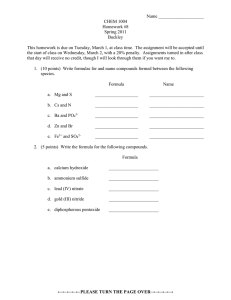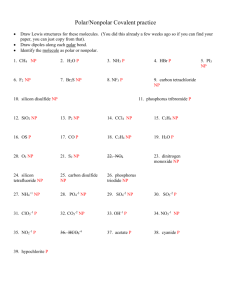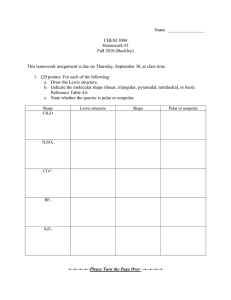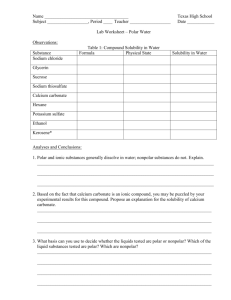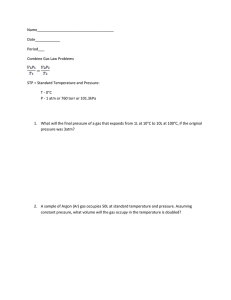PRACTICE PROBLEMS FOR EXAM THREE CHAPTER 7 (part); 8; 12 CHEM 1311
advertisement
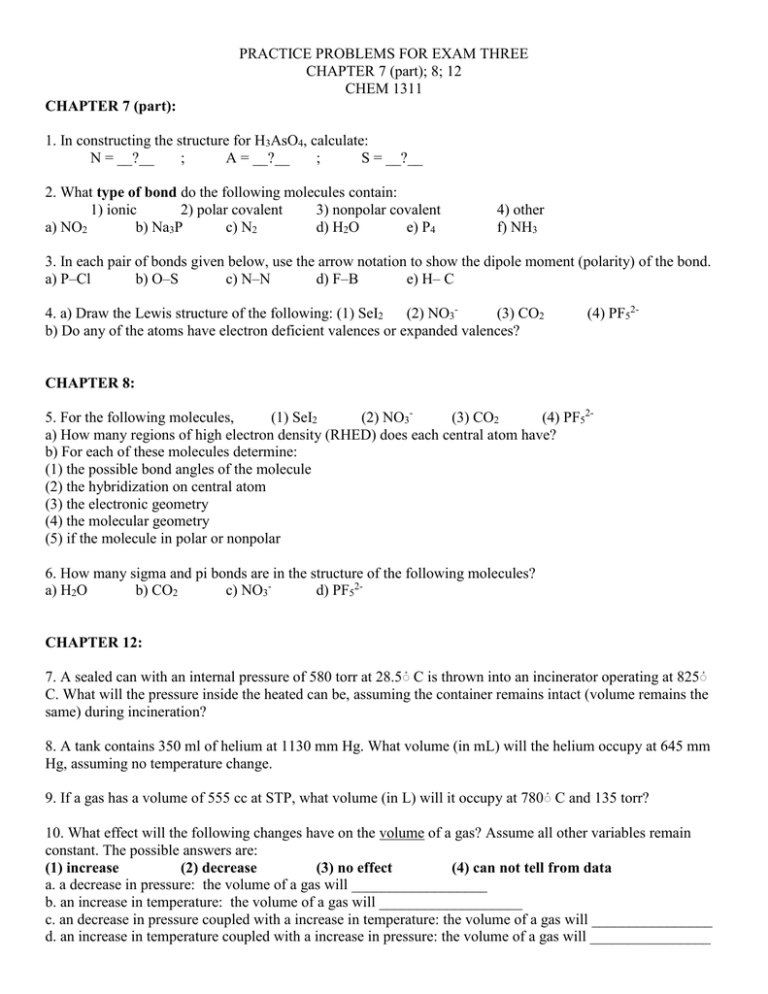
PRACTICE PROBLEMS FOR EXAM THREE CHAPTER 7 (part); 8; 12 CHEM 1311 CHAPTER 7 (part): 1. In constructing the structure for H3AsO4, calculate: N = __?__ ; A = __?__ ; S = __?__ 2. What type of bond do the following molecules contain: 1) ionic 2) polar covalent 3) nonpolar covalent a) NO2 b) Na3P c) N2 d) H2O e) P4 4) other f) NH3 3. In each pair of bonds given below, use the arrow notation to show the dipole moment (polarity) of the bond. a) P–Cl b) O–S c) N–N d) F–B e) H– C 4. a) Draw the Lewis structure of the following: (1) SeI2 (2) NO3(3) CO2 b) Do any of the atoms have electron deficient valences or expanded valences? (4) PF52- CHAPTER 8: 5. For the following molecules, (1) SeI2 (2) NO3(3) CO2 (4) PF52a) How many regions of high electron density (RHED) does each central atom have? b) For each of these molecules determine: (1) the possible bond angles of the molecule (2) the hybridization on central atom (3) the electronic geometry (4) the molecular geometry (5) if the molecule in polar or nonpolar 6. How many sigma and pi bonds are in the structure of the following molecules? a) H2O b) CO2 c) NO3d) PF52- CHAPTER 12: 7. A sealed can with an internal pressure of 580 torr at 28.5ْ C is thrown into an incinerator operating at 825ْ C. What will the pressure inside the heated can be, assuming the container remains intact (volume remains the same) during incineration? 8. A tank contains 350 ml of helium at 1130 mm Hg. What volume (in mL) will the helium occupy at 645 mm Hg, assuming no temperature change. 9. If a gas has a volume of 555 cc at STP, what volume (in L) will it occupy at 780ْ C and 135 torr? 10. What effect will the following changes have on the volume of a gas? Assume all other variables remain constant. The possible answers are: (1) increase (2) decrease (3) no effect (4) can not tell from data a. a decrease in pressure: the volume of a gas will __________________ b. an increase in temperature: the volume of a gas will ___________________ c. an decrease in pressure coupled with a increase in temperature: the volume of a gas will ________________ d. an increase in temperature coupled with a increase in pressure: the volume of a gas will ________________ 11. According to the kinetic-molecular theory, what change in temperature is occurring if the particles of a gas on average begin to move more rapidly? 12. According to the kinetic-molecular theory, what change in pressure occurs when the walls of the container are struck less often on average by particles of a gas? 13. Container B has three times the volume and holds three times as many gas particles as container A. Using the kinetic-molecular theory and gas laws as a basis for your answer, compare the pressures in the two containers. Assume both containers are at the same temperature. 14. How many liters is 4.81g of SO2 at STP? 15. What volume, in mL, of NO at STP can be produced by dissolving 25.3 g of Pb in excess HNO3? 3 Pb + 8 HNO3 —> 3 Pb(NO3)2 + 2 NO + 4 H2O 16. Calculate the density of carbon dioxide gas (g/L) at 1.55 atm and 25°C. 17. A 250 mL sample of O2 was collected over water at 21°C when the atmospheric pressure was 742 torr. What is the mass of the oxygen sample? 18. What is the formula weight (molar mass) of a gas if 0.555 g occupies 62.3 mL at STP? 19. What is the pressure (in atm) of 125.3 g of propane, C3H8, in 2000 mL at -55°C? 20. How many grams of HCl are needed to provide 100.0 L of Cl2 gas at 48°C and 3.33 atm? 2 KMnO4 + 16 HCl —> 8 H2O + 2 KCl + 2 MnCl2 + 5 Cl2 ANSWERS: 1. N = 46 ; A = 32 ; S = 14 2. a) polar cov. b) ionic c) nonpolar cov. d) polar cov. e) nonpolar cov. f) polar cov. 3. P– Cl O– S N– N F– B H– C 4. .. :F: :F: 2.. \ .. / .. :F — P — F: ¨ │ ¨ :F: ¨ .. .. .. :O=C=O: :O: 1.. ║ .. :O — N — O: ¨ ¨ (b) PF52- has an expanded valence .. .. .. :I — Se — I : ¨ ¨ ¨ 5. a) SeI2 (4 RHED) NO3- (3 RHED) CO2 (2 RHED) PF52- (6 RHED) b) Molecule Bond angles hybridization of central atom SeI2 109.5° sp3 tetrahedral bent (angular) polar NO3- 120° sp2 trigonal planar trigonal planar nonpolar CO2 180° sp linear linear nonpolar PF52- 180°; 90° sp3d2 octahedral square pyramidal polar electronic geometry molecular geometry polarity of molecule 6. a) H2O; 2 sigma, 0 pi b) CO2; 2 sigma, 2 pi c) NO32-; 3 sigma, 1 pi 7. 2112.2 torr 8. 613.2 mL 9. 12.05 L 10. a) increase b) increase c) increase d) can not tell from data 11. the temperature of the gas sample is increasing 12. the pressure of the gas sample is decreasing 13. the pressure is the same in both containers 14. 1.68 L 15. 1824 mL 16. 2.79 g/L 17. 0.315 g 18. 199.7 g/mol 19. 25.5 atm 20. 1475.8 g d) PF52-; 5 sigma, 0 pi
